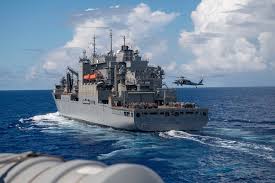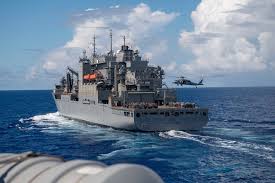
The U.S. Navy, a symbol of resilience, has recently announced plans to sideline 17 Military Sealift vessels due to a significant manpower shortages. This decision, while highlighting ongoing challenges in maintaining operational readiness across the fleet, also underscores the Navy’s ability to adapt and overcome. The Navy is grappling with a shortage of qualified personnel, which has become an urgent issue. As a result, the Military Sealift Command has drafted a comprehensive plan to address these shortages.
To mitigate the impact of this manpower shortage, the proposed initiative focuses on extended maintenance and crew redistribution. The Navy hopes to optimize the available workforce and ensure critical operations continue without interruption. However, the plan is still pending approval from the Chief of Naval Operations, Adm. Lisa Franchetti.
One of the primary goals of this initiative is to reduce officer demands by 700 mariners. This reduction is crucial for ensuring the Navy can maintain its operational tempo without overburdening its personnel. Furthermore, the plan emphasizes the need for strategic adjustments to the current deployment model. This includes identifying vessels that can undergo extended maintenance and freeing crew members for reassignment to other ships.
Transitioning to a more sustainable operational model is essential for the Navy’s future. While this plan addresses immediate concerns, it also sets the stage for long-term improvements. The Navy aims to balance its resources more effectively, ensuring that all vessels are adequately staffed and maintained. By redistributing crew members, the Navy can enhance the overall efficiency of its operations.
Moreover, the proposed changes are expected to have a positive impact on the morale and well-being of Navy personnel. By reducing the pressure on current officers and crew, the Navy is demonstrating its commitment to creating a more supportive work environment. This, in turn, could lead to increased retention rates and a more motivated workforce, showing the Navy’s value for its personnel.
However, the success of this initiative hinges on the approval of Adm. Lisa Franchetti. Her decision will determine whether the Navy can move forward with these critical changes. It is vital for the Navy to adapt quickly to these challenges to maintain its strategic advantage, a point that cannot be overstated. Therefore, the emphasis on reducing officer demands and optimizing crew distribution is crucial.
The Navy’s plan to sideline 17 vessels due to manpower shortages is necessary to address current operational challenges. The focus on extended maintenance and strategic crew redistribution is designed to enhance efficiency and reduce the strain on personnel. As the Navy awaits Adm. Franchetti’s approval, this initiative’s importance is evident. Not only does it address immediate staffing issues, but it also lays the groundwork for a more sustainable and resilient future. By prioritizing these changes, the Navy is taking essential strides toward maintaining its readiness and operational capabilities.




